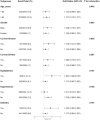Association between the cumulative average triglyceride glucose-body mass index and cardiovascular disease incidence among the middle-aged and older population: a prospective nationwide cohort study in China
- PMID: 38184577
- PMCID: PMC10771655
- DOI: 10.1186/s12933-023-02114-w
Association between the cumulative average triglyceride glucose-body mass index and cardiovascular disease incidence among the middle-aged and older population: a prospective nationwide cohort study in China
Abstract
Background: Findings from earlier research have established that insulin resistance (IR) is implicated in atherosclerosis progression, representing a noteworthy risk factor for cardiovascular disease (CVD). Recently, the triglyceride glucose-body mass index (TyG-BMI) has been introduced as a straightforward and robust alternative indicator for early detection of IR. Nevertheless, there is a scarcity of studies that have examined the capability of TyG-BMI for predicting incident CVD. Consequently, the core objective of this study was to determine whether the cumulative average TyG-BMI correlated with CVD incidence.
Methods: All data was sourced from the China Health and Retirement Longitudinal Study (CHARLS). The exposure was the cumulative average TyG-BMI, determined by the average of TyG-BMI values for the baseline and follow-up investigations (Wave 1 in 2011, Wave 3 in 2015, respectively). The calculation of TyG-BMI involved a combination of triglyceride, fasting blood glucose, and body mass index. The primary outcome was incident CVD. Logistic regression analyses as well as restricted cubic spline (RCS) regression analyses were performed for examining the association between the cumulative average TyG-BMI and CVD incidence.
Results: In all, 5,418 participants were enrolled in our analysis, with 2,904 (53.6%) being female, and a mean (standard deviation, SD) age of 59.6 (8.8) years. The mean (SD) cumulative average TyG-BMI among all participants was 204.9 (35.7). Totally, during a 4-year follow-up, 543 (10.0%) participants developed CVD. The fully adjusted logistic regression analysis revealed a significant association between the cumulative average TyG-BMI and incident CVD [odds ratio (OR), 95% confidence interval (CI): 1.168, 1.040-1.310, per 1 SD increase]. The RCS regression analysis displayed a positive, linear association of the cumulative average TyG-BMI with CVD incidence (P for overall = 0.038, P for nonlinear = 0.436).
Conclusions: Our study revealed a noteworthy correlation between the cumulative average TyG-BMI and incident CVD among the middle-aged and older population. The cumulative average TyG-BMI emerges as a valuable tool that may enhance the primary prevention and treatment of CVD.
Keywords: CHARLS; Cardiovascular disease; Insulin resistance; Prospective cohort study; TyG-BMI.
© 2024. The Author(s).
Conflict of interest statement
The authors declare that they have no competing interests.
Figures





Similar articles
-
Association between the triglyceride glucose-body mass index and future cardiovascular disease risk in a population with Cardiovascular-Kidney-Metabolic syndrome stage 0-3: a nationwide prospective cohort study.Cardiovasc Diabetol. 2024 Aug 7;23(1):292. doi: 10.1186/s12933-024-02352-6. Cardiovasc Diabetol. 2024. PMID: 39113004 Free PMC article.
-
Triglyceride-glucose index as a mediator of body mass index and cardiovascular disease in middle-aged and older Chinese adults: a nationally representative longitudinal cohort study.Front Endocrinol (Lausanne). 2024 Dec 23;15:1431087. doi: 10.3389/fendo.2024.1431087. eCollection 2024. Front Endocrinol (Lausanne). 2024. PMID: 39764243 Free PMC article.
-
Association between cumulative average triglyceride glucose-body mass index and the risk of CKD onset.Front Endocrinol (Lausanne). 2025 Mar 31;16:1525078. doi: 10.3389/fendo.2025.1525078. eCollection 2025. Front Endocrinol (Lausanne). 2025. PMID: 40230478 Free PMC article.
-
Association between triglyceride glucose-body mass index and obstructive sleep apnea: a study from NHANES 2015-2018.Front Nutr. 2024 Aug 16;11:1424881. doi: 10.3389/fnut.2024.1424881. eCollection 2024. Front Nutr. 2024. PMID: 39221158 Free PMC article. Review.
-
Association of triglyceride-glucose index with bone mineral density and fracture: a systematic review.Diabetol Metab Syndr. 2025 Mar 4;17(1):77. doi: 10.1186/s13098-025-01642-7. Diabetol Metab Syndr. 2025. PMID: 40038837 Free PMC article. Review.
Cited by
-
Association of the body roundness index with new-onset cardiovascular disease in middle-aged and older adults with and without diabetes: evidence from the China Health and Retirement Longitudinal Study.Diabetol Metab Syndr. 2025 Apr 28;17(1):142. doi: 10.1186/s13098-025-01705-9. Diabetol Metab Syndr. 2025. PMID: 40296132 Free PMC article.
-
Association between triglyceride glucose body mass index and 1 year all cause mortality in stage 4 CKM syndrome patients.Sci Rep. 2025 May 16;15(1):17019. doi: 10.1038/s41598-025-01549-3. Sci Rep. 2025. PMID: 40379745 Free PMC article.
-
Association between modified triglyceride glucose indices and stroke risk in middle-aged and older Chinese adults: a prospective cohort study.Cardiovasc Diabetol. 2025 Jul 10;24(1):274. doi: 10.1186/s12933-025-02827-0. Cardiovasc Diabetol. 2025. PMID: 40640840 Free PMC article.
-
Unraveling the role of cumulative triglyceride-total cholesterol-body weight index in stroke development: evidence from the CHARLS cohort.Front Med (Lausanne). 2025 Jul 10;12:1616520. doi: 10.3389/fmed.2025.1616520. eCollection 2025. Front Med (Lausanne). 2025. PMID: 40708645 Free PMC article.
-
Associations of cumulative exposure and dynamic trajectories of the C-reactive protein-triglyceride-glucose index with incident cardiovascular disease in middle-aged and older Chinese adults: a nationwide cohort study.Cardiovasc Diabetol. 2025 Jul 26;24(1):303. doi: 10.1186/s12933-025-02869-4. Cardiovasc Diabetol. 2025. PMID: 40713770 Free PMC article.
References
-
- Roth GA, Mensah GA, Johnson CO, Addolorato G, Ammirati E, Baddour LM, Barengo NC, Beaton AZ, Benjamin EJ, Benziger CP, et al. Global burden of cardiovascular diseases and risk factors, 1990–2019: update from the GBD 2019 study. J Am Coll Cardiol. 2020;76(25):2982–3021. doi: 10.1016/j.jacc.2020.11.010. - DOI - PMC - PubMed
-
- Dagenais GR, Leong DP, Rangarajan S, Lanas F, Lopez-Jaramillo P, Gupta R, Diaz R, Avezum A, Oliveira GBF, Wielgosz A, et al. Variations in common diseases, hospital admissions, and deaths in middle-aged adults in 21 countries from five continents (PURE): a prospective cohort study. Lancet. 2020;395(10226):785–794. doi: 10.1016/S0140-6736(19)32007-0. - DOI - PubMed
-
- Shulman GI. Ectopic fat in insulin resistance, dyslipidemia, and cardiometabolic disease. N Engl J Med. 2014;371(23):2237–2238. - PubMed
Publication types
MeSH terms
Substances
Grants and funding
LinkOut - more resources
Full Text Sources

